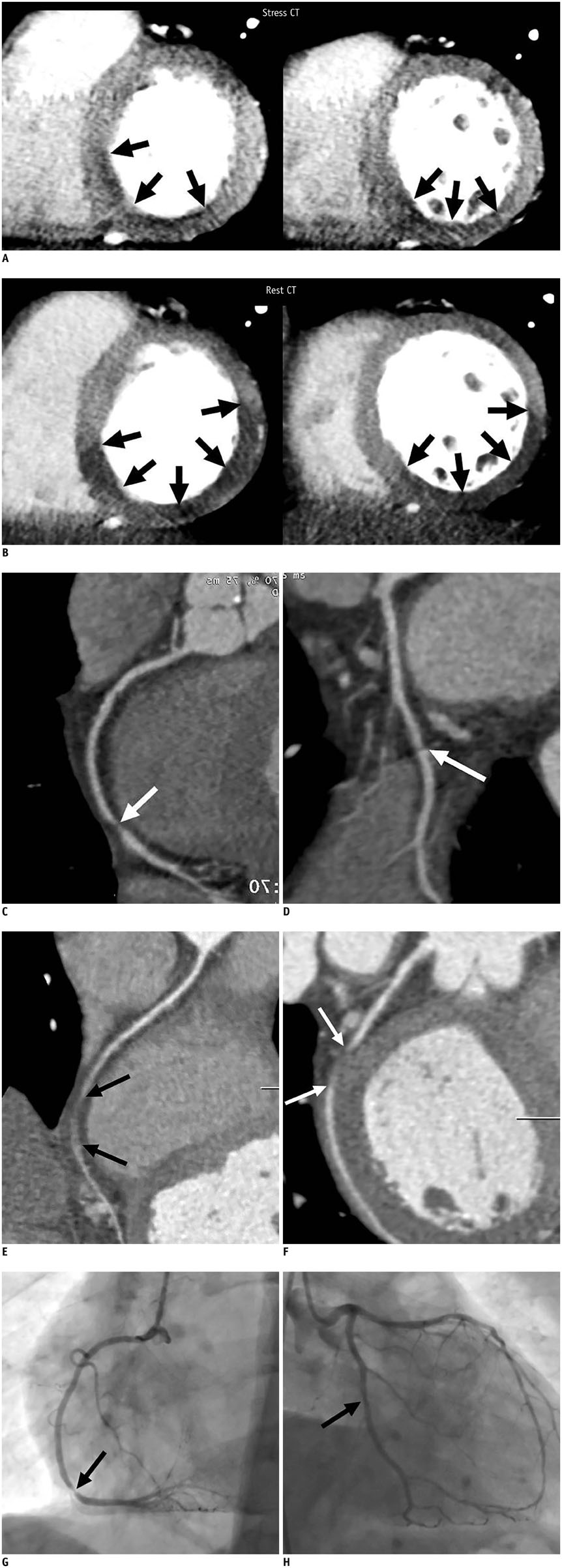Korean J Radiol.
2015 Jun;16(3):673-677. 10.3348/kjr.2015.16.3.673.
Development of Coronary Vasospasm during Adenosine-Stress Myocardial Perfusion CT Imaging
- Affiliations
-
- 1Department of Radiology, Ulsan University Hospital, University of Ulsan College of Medicine, Ulsan 682-714, Korea. drcsh@naver.com
- KMID: 2155540
- DOI: http://doi.org/10.3348/kjr.2015.16.3.673
Abstract
- Adenosine is a short-acting coronary vasodilator, and it is widely used during pharmacological stress myocardial perfusion imaging. It has a well-established safety profile, and most of its side effects are known to be mild and transient. Until now, coronary vasospasm has been rarely reported as a side effect of adenosine during or after adenosine stress test. This study reports a case of coronary vasospasm which was documented on stress myocardial perfusion CT imaging during adenosine stress test.
MeSH Terms
Figure
Reference
-
1. Anagnostopoulos C, Harbinson M, Kelion A, Kundley K, Loong CY, Notghi A, et al. Procedure guidelines for radionuclide myocardial perfusion imaging. Heart. 2004; 90:Suppl 1. i1–i10.2. Weissman G, Scandrett RM, Howes CJ, Russell RR 3rd. Coronary vasospasm during an adenosine stress test. J Nucl Cardiol. 2004; 11:747–750.3. Faganello G, Belham M. Coronary vasospasm during an adenosine stress test. Int J Cardiol. 2006; 113:E84–E86.4. Golzar J, Mustafa SJ, Movahed A. Chest pain and ST-segment elevation 3 minutes after completion of adenosine pharmacologic stress testing. J Nucl Cardiol. 2004; 11:744–746.5. Rosenberg T, Perdrisot R. Coronary spasm after an adenosine stress test: an adverse effect of a vasodilator. Acta Cardiol. 2008; 63:401–404.6. Nakayama M, Morishima T, Chikamori T, Aiga M, Takazawa K, Yamashina A. Coronary arterial spasm during adenosine myocardial perfusion imaging. J Cardiol. 2009; 53:288–292.7. Han PP, Tian YQ, Wei HX, Wang Q, He ZX. Coronary spasm after completion of adenosine pharmacologic stress test. Ann Nucl Med. 2011; 25:580–585.8. Cerqueira MD, Verani MS, Schwaiger M, Heo J, Iskandrian AS. Safety profile of adenosine stress perfusion imaging: results from the Adenoscan Multicenter Trial Registry. J Am Coll Cardiol. 1994; 23:384–389.9. Baskot B, Rafajlovski S, Ristic´-Angelkov A, Obradovic´ S, Gligic´ B, Orozovic´ V, et al. [Study of efficacy and safety of pharmacological stress tests in nuclear cardiology]. Vojnosanit Pregl. 2009; 66:193–198.10. Sato A, Terata K, Miura H, Toyama K, Loberiza FR Jr, Hatoum OA, et al. Mechanism of vasodilation to adenosine in coronary arterioles from patients with heart disease. Am J Physiol Heart Circ Physiol. 2005; 288:H1633–H1640.11. Miyagawa M, Kumano S, Sekiya M, Watanabe K, Akutzu H, Imachi T, et al. Thallium-201 myocardial tomography with intravenous infusion of adenosine triphosphate in diagnosis of coronary artery disease. J Am Coll Cardiol. 1995; 26:1196–1201.12. Feuchtner G, Goetti R, Plass A, Wieser M, Scheffel H, Wyss C, et al. Adenosine stress high-pitch 128-slice dual-source myocardial computed tomography perfusion for imaging of reversible myocardial ischemia: comparison with magnetic resonance imaging. Circ Cardiovasc Imaging. 2011; 4:540–549.13. Ansari HR, Teng B, Nadeem A, Roush KP, Martin KH, Schnermann J, et al. A(1) adenosine receptor-mediated PKC and p42/p44 MAPK signaling in mouse coronary artery smooth muscle cells. Am J Physiol Heart Circ Physiol. 2009; 297:H1032–H1039.14. Hung MJ, Hu P, Hung MY. Coronary artery spasm: review and update. Int J Med Sci. 2014; 11:1161–1171.
- Full Text Links
- Actions
-
Cited
- CITED
-
- Close
- Share
- Similar articles
-
- Stress Testing and Imaging Protocols for Myocardial Perfusion Studies
- The Combined Use of Adenosine Stress Echocardiography and Myocardial Perfusion Imaging for Diagnosis of Coronary Artery Stenosis in Angina Patients
- Clinical Utility of Coronary CT Angiography with Stress Perfusion CT in Preoperative Cardiac Risk Evaluation
- Clinical Applications of CT Myocardial Perfusion Imaging
- Effect of Background Subtraction on Thallium-201 Kinetics in Myocardium : Comparison between Exercise and Pharmacologic Test with Adenosine, Dipyridamole, or Dobutamine


